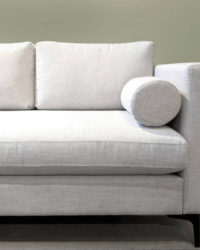What to look for when buying a sofa
Posted on December 17, 2019There is no shortage of selection when it comes to buying a sofa. Quality and therefore the potential lifespan of the sofa is difficult to identify when a piece is fully upholstered. It is important to be able to ask where the sofa is actually constructed and to find out how it is put together.
In our experience we have found that North American made sofas generally are better made with materials that meet stricter environmental guidelines, they also tend to have better stitching than an import sofa.
Here we discuss some of the things to look for and to ask about when shopping for upholstered pieces:
-
How is it made?
Frame

Is the frame made of solid wood?
Some frames are made of particle board which will deteriorate with use. Frames made of solid wood will last much longer, also make sure that the wood is kiln dried so there won’t be any warping or splitting which is something that can happen with green wood.
The construction may also include stapling and gluing; corner blocked frames will ensure that the frame will be solid.
Legs
How are they attached and what are they made of? Legs should be screwed into or onto the frame, and preferably made of either solid wood or metal. Plastic legs can easily crack with use.
Material

Most fabrics used for sofas have a Double Rub Count denoted.
Double Rub Count is a measurement of the durability of the material, the way that the count is determined is by utilizing a mechanized arm to move a piece of heavy cotton cloth across the material. Each back and forth movement is a double rub, this is repeated until there is significant wear, thus the rub count is a great indicator as to the general wear of the fabric. Heavy duty for home use, is anything with a 15,000 or higher double rub count, over 30,000 is considered a great fabric for commercial use.
If your sofa is going to be young children or pets, we will often recommend a fabric with a built in stain protection or a microfiber for easier spot cleaning.
The ‘Sit’



How comfortable a sofa is for you is going to depend on many different factors: seat height and depth, and seat fill. A higher seat, whether due to higher legs or a higher seat deck will generally feel a little firmer and more formal. Generally your weight will be distributed more through the thigh area, creating a more upright sit. A lower seat height is ideal for a more relaxed, lounging position and will give a cushier impression as the weight is more centred through the hips.
There are also many different types of foam and often companies will have a range of choices available from their regular standard foam, to a firmer foam or even options of a foam/feather blend or a feather wrapped foam. For foam inserts, a Dacron wrap will help to ensure that the fabric does not slip over the insert. Foam/feather blends are probably the cushiest, but they can become compressed, and regularly need to be shaken to regain the form. Feather wrapped foam is the best of both worlds, the soft feeling of the feathers, but the low maintenance of the foam as it will not compress.
The Style
This is completely down to personal preference, and we could not even attempt to say that one style is better than another. We can say that there are millions of styles to choose from and the most important factors are that they are well made and comfortable for you!
The Size
When in a store or showroom, most of which may be bigger than your space at home, it is easy to lose perspective on a sofa’s scale. It is important to know the room’s dimensions, what other furniture may be in it, and what other functionality the room may serve. If you need to fit in a couple of occasional chairs or a dining nook, then that will dramatically impact the size of the sofa that will fit.

Other factors that may impact are access into the space, such as where are the doorways, or is there a sliding door, and what will the ‘traffic flow’ be? A sofa that is significantly higher than the window sill may impede your lovely view, or a chaise on a sectional right near a doorway may make it awkward to enter the room. It can be quite helpful to bring a rough sketch of the room’s floorplan and dimensions while shopping along with a photo or two.
Lastly, can the sofa you’ve chosen actually access into the space? By this we mean, does it have to go through a tight corridor with a slight jog? Does it have to go into an elevator or be carried up a stairwell and around a landing or through a narrow doorway? It is important to measure the path of the sofa from the curb to the final spot, especially if the sofa is made to order as it is made specifically for you and is most likely a final sale. Save yourself any unpleasant surprises and double check your access points.
We hope that these ‘pointers’ will help you in your search for the perfect sofa!
BACK
